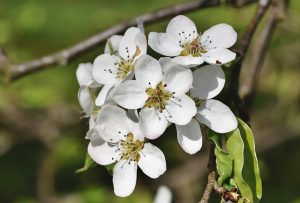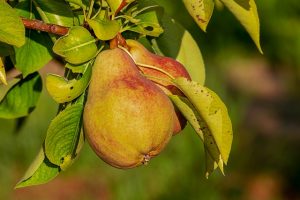Pears are possible the juiciest fruit around. Nothing beats that feeling of gorging as you bite into the ripe flesh. It remains one of the joys of late Summer and Autumn. If we are lucky, there may already be one pear tree in the garden otherwise it’s a case of putting a small one into the garden or even trying one in a container. Growing them is relatively easy and the reward is all those fine pears. Every orchard should contain at least one pear tree to complement the apples grown. They also make a fine perry when fermented. Pear cultivation is almost if not older than apple growing.

Varieties:-
Beth – A excellent pear for small gardens as it produces a small compact tree. the small-medium yellow fruits are smooth skinned with creamy white, very juicy melting flesh. A reliable an heavy cropper producing fruit from a young age. Suitable for the north. Season: August to September.
Beurre Hardy – First raised in 1820 so a an old variety but one of the finest flavoured dessert pears and excellent choice for the garden. the medium-large fruits are soft and juicy and covered in bronze russet. sweet and aromatic with a hint of rosewater according to Pomona. Heavy cropping . resistant to scab. the blossom is frost resistant but the tree requires a warm location. main cropping season is October.
Concorde – One of the great pears and grown commercially as its so ideally suited to most locations. Raised from a cross between Doyenne du Comice and Conference, it has inherited the best attributes of both parents. The medium to large pale green fruits have a smooth, juicy flesh with a sweet pleasant flavour. Suitable for dessert and culinary use. A compact tree. cropping heavily and reliably from an early age. Season is October.
Conference – Now 100 years old and the best known pear in the business having been popular for years in the UK as it is suitable for so many locations. The long narrow fruits are firm and juicy with a sweet, pleasant, slightly stony flavour. Good all-rounder and reliable as a heavy cropper and self-fertile. Suited to both culinary and dessert use. Reliable and heavy cropping. Produces a compact tree which has been developed over many years. Season for fruiting is October to November. For containers or a tight space, find a ‘Conference’ variety grown on a rootstock such as Quince C or Quince Eline.
‘Doyenne Du Comice’ – First raised in 1849 as one of the finest flavoured and most popular of all pears. produces large green-yellow fruits, sometimes with a red flush. the flesh is smooth and very juicy with a sweet, delicious flavour. the tree needs a warm location in order to crop well. Season is late – October into November.
‘Invincible [Delwinor fertilia]’– ideal for an exposed situation. Tough and a hardy self-fertile form that produces a second flowering after heavy frost which has led to its ‘Invincible’ name. heavy cropping from an early age. The fruits are very large with sweet, juicy flesh. Suitable for dessert and culinary purposes. Season: October to November. Great for cooking or eating fresh so regarded as a dual purpose pear.
Louise Bonne Of Jersey – rated highly for its great flavour as this variety dates back to the early 1700s. Medium-sized fruits are pale green-yellow with a deep red flush. the flesh is tinged pink, totally smooth, juicy and very sweet. The blossom has good frost resistance. A reliable cropper, suitable for the north. Season is September to October. Will not cross-pollinate with Williams; or vice versa.
Obelisk – A dwarf pear and an excellent recommendation being self-fertile which means only one tree is needed. Has a tidy, upright manner and ideal for the small garden, pot or patio. Comes from Slovakia. The medium sized fruits are green, occasionally with a red flush. the flesh is firm with a delicate sweet flavour. Suitable for dessert and culinary purposes. One very useful feature of this variety is the storage quality of the fruit. Picked early to mid October, the fruits can be stored for several months ina refrigerator. Suitable for growing in most of the UK. Season is early October to January.
Onward – a great dessert pear with a flavour similar to Comice and much more reliable. has medium-sized fruits with a smooth pale green and yellow skin. Flesh is fine, soft and juicy with a superb sweet flavour. A good heavy cropper and said to be reliable in cold climates. Does not cross pollinate with Comice or vice versa.
Williams’ Bob Chretien – started in 1770 and might be the most common of all the pears in cultivation. Ideal for culinary and dessert use. has medium-sized fruits with a pale green or golden skin finish. The flesh is weet, smooth and very juicy. Reliable and heavy cropper which is suited to growing in cold regions. Partly self-fertile. usually harvest fruit in September onwards.
It’s important though to consider aspects of pears before growing them. Here we cover the main points.
Planting
The best sites for a pear tree are sunny, sheltered walls which are east or south facing as frost damage of blossom can be an issue. Good soil is needed as poor drainage and weak soil depth produce low yields of fruit.
Consider the size of the pear tree as they can grow exceptionally tall.
Pear trees like many fruit trees come in two types:-
- bare-root stock with roots literally exposed on point of purchase. Choose a reputable nursery for all your tree requirements !
- container specimens.
Plant bare rooted trees in autumn (from September onwards) while the soil is still warm and the tree dormant. Container grown trees may be planted at any time of year as long as the soil is not frozen or completely sodden.
Growing On Pears
Extremely easy once they are established and need little attention throughout the year.
Water when the ground is exceptionally dry. It certainly helps when a young pear tree is trying to establish itself in a container.

Fertilizer
If the soil is impoverished, then add fertilizer like Growmore once a year which is all that’s needed. Don’t over-fertilize as this produces plenty of leaf but not fruit unless that is the intention. With our trees, we made sure the soil was rich enough to allow the tree to develop its branches and leaf without wishing for fruit that year. If you have one or two trees, some fruit tree fertilizer spikes are just the job. Easy to use with a slow measured release of fertilizer that will cover the whole year.
Fruiting & Harvesting:
August–October, depending on the variety. Pears do not ripen on the tree but when they have dropped to the ground.
Storage Of Pears:
They will store in the fridge for a couple of weeks.
Pruning
- Take your time and stay safe – if you need to go up a ladder, consider investing in a special fruit tripod ladder that will let you get nice and close to the branches (great for picking fruit too).
- Get the secateurs as sharp as possible and buy a quality pruning saw for dealing with larger branches.
Pruning a pear tree begins in late winter before the buds begin to swell. Earlier pruning may encourage excessive vegetative growth and suckering in spring and summer. It also increases the chances of winter injury to the pruning sites. Limit spring and summer pruning to light thinning, and try to avoid trimming pear trees after midsummer.
Pear tree pruning also begins at planting time. Cut back young, unbranched trees 33 to 36 inches above the ground to encourage good branching. If your new tree has plenty of branches, remove those that are less than 18 inches from the ground and those with crotches of less than 60 degrees.
Pests & Diseases
When you consider the diseases other fruit trees suffer from, pears are straightforward. Likewise, insect damage is not as common as people think.
Pears are only ever troubled by a few diseases such as the fungal disease brown rot, when a brown rot spreads through the fruit. Remove any rotten fruit as soon as you see them.
Scab will blemish the fruit skins with black marks. There are no fungicides to deal with this. Leaves will also be affected and so when they fall, scoop as many of them up as possible. Bin or burn them but don’t compost. Encourage resistance to the disease by feeding the surrounding area with 1oz. (28g) per sq.m. of sulphate of potash. Apply monthly from April to September by sprinkling over the rooting area and watering in.
If you see pear rust which are orange spots on the leaves then remove all the affected leaves as soon as you see them.
Pear leaf blister mite does not affect the crop, but will leave yellow and red blisters of the leaves.
Specialist Nurseries
Frank P. Matthews (www.frankpmatthews.com) Worcs. UK.
Pomona Fruits (www.PomonaFruits.co.uk) Walton-On-Naze, Essex. UK.
Leave a Reply